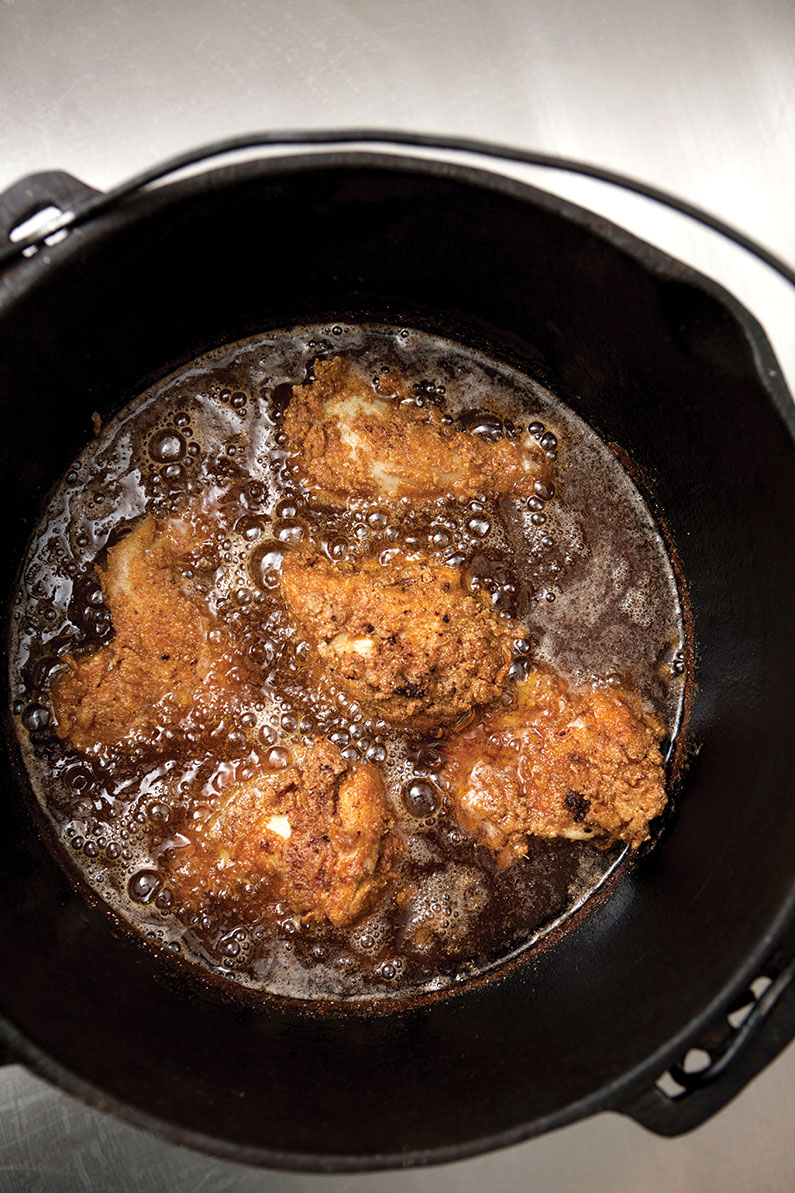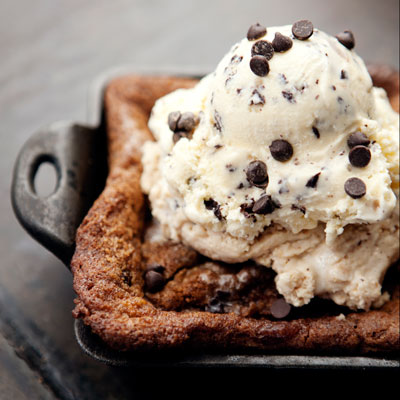Cooking with cast iron
like cooking. I love cookware. Sturdy oversized roasters. Shiny stainless pots. Polished copper sauciers. So when I ruined my everyday nonstick skillet with metal utensils, I was giddy at the prospect of replacing it. But with what?
An enameled, cast-iron Le Creuset French oven (think Dutch oven from le France) is the prom queen of my kitchen: posh, pretty and popular with all the recipes. She heats without hot spots and moves from stove top to oven effortlessly. You wouldn’t have to twist my arm to get an LC skillet. But you would have to twist my wallet – I’d have to spend at least $100 for a 10-inch pan.
A Lodge cast-iron skillet without an enamel coating heats just as beautifully for around $20. And food cooked in bare cast iron actually adds small amounts of iron to your diet, which is helpful if you aren’t a fan of leafy greens.
But cast-iron skillets have a high-maintenance reputation. Food sticks and the pans rust if they aren’t “seasoned.” Contrary to the name, seasoning does not mean flinging salt and pepper around. It’s a process by which you grease the inside of your pan with Crisco or lard and then heat it. The grease soaks into the pores of the pan, creating a smooth, nonstick surface. (Unlike manufactured nonsticks, this one is chemical-free.) Here’s the best part: The surface improves every time you cook with fats. So if you’re lucky enough to purchase or inherit an old pan that has been seasoned by hundreds of suppers before you, you may never have to season it in the oven at all.
If you’d prefer to buy a new pan, the current Lodge line of cookware is labeled “Foundry Seasoned.” Think of this pre-seasoning as a good, but incomplete, start. To make your Lodge truly nonstick, and before you cook anything really acidic like tomato sauce (which can eat away the patina), you need to season it a bit more. There are a million different ways to season cast iron, but my favorite is to just fry a few pounds of bacon in it before I cook anything else. (Further proof that few problems in this world can’t be fixed with a few strips of fatty swine.)

So, once you’ve fried your bacon, how do you clean the skillet? Conventional wisdom says that dish soap will break down the patina, forcing you to season the pan more often. Current wisdom says that not using soap on a greasy pan is gross. I’m squarely in the middle. If I can wipe my pan clean with a paper towel after, say, making a quesadilla, I’m done. But when I make fish, you better believe I use soap. Just a little though and I never, ever put it in the dishwasher. I just rub a little kosher salt on the burned bits to ease them away, then I heat the clean pan on a warm burner to coax out any rust-causing water droplets. Lastly, I give it a final wipe with a vegetable-oiled towel. Trouble? Nothing’s too much trouble for this gorgeous gem.
The mystique of cast iron is that you don’t really own it. You just nurture it until its next cook comes along. David Smith is a collector and seller of vintage Wagner- and Griswold-brand cast-iron pieces. On his website, PanMan.com, I found the most beautiful 1930s-era 10-inch Wagner skillet you can imagine for only $25. The inside is smooth and glossy like black glass; it compels me to pamper it. And cook in it. And feed it bacon.
Apparently, pan-enchantment is a real thing. Cary McDowell gets inspired by the cast-iron collection he covets at Winslow’s Home. “I look at the pieces and want to fill them with something special,” the executive chef said dotingly as if speaking about each of his children. For Winslow’s Fried Chicken Tuesdays, he fills his 15-inch Lodge skillet with peanut oil and fries chicken using a technique he learned from his grandmother. “I submerge the chicken a half at a time. I don’t deep-fry it, because that’s the way my nana taught me.” He also depends on vintage cast iron for a scallops entree, which he begins by heating a blend of peanut and olive oil until it shimmers and shakes. Scallops quickly join the party, sizzling and searing into the skillet’s fiery surface. McDowell tucks hearty greens into the pan’s empty nests and lets the buttery mollusks steam in the juices seeping from the wilting leaves. The result is a chunky, fresh sea scallop that’s cooked evenly, perfectly, deliciously.
Chef Brandon Benack’s cast-iron memories reach all the way back to his grandmother, who seared plump little meatballs in a dark-black cast-iron skillet. At Truffles, Benack has cast-iron skillets dedicated to searing fish and chicken. “There’s just a unique taste you get,” he said. “It comes from the seasoning in the pan.” Another set of cast iron is reserved for his Gooey Butter Brownie, a chewy, gluttonous dessert of deep-dark chocolate, vanilla butter and fresh berries. “They bake better in the cast iron,” he noted, “more evenly.”

In decades past, uncoated cast iron stayed in the kitchen while its prettier, enameled cousin got to take the esteemed trip out to the dining room. But chef Justin Haifley likes the rustic look of the skillets on his tables at The Tavern Kitchen and Bar, where cozy, comfort food is given a contemporary bent. In fact, individually sized cast-iron dishes replace shiny white plates for all of the side dishes and most of the desserts at the Valley Park restaurant. Like Haifley’s truffle mushroom mac-n-cheese – a rich combination of a basic roux to which Haifley stirs in half-and-half and a little Parmesan, followed by cremini mushrooms, sharp green onions, a little fresh thyme and a glug of Madeira wine. This ultimate carb indulgence gets capped with an ode to the decadent: deeply earthy, garlicky truffle oil.
Mathew Unger also opts for cast iron to deliver hearty fare to the tables at his restaurant, Mathew’s Kitchen in South City. The skillets are the ideal vessels for sealing in a perfect crust on everything from Unger’s Shepherd’s Pie to his equally satisfying Chicken Pot Pie. For the limited-time Lenten version, Unger combines the buttery meat of a lobster’s tail with a classic mixture of peas, carrots, corn and potatoes. Everything gets poured into a piecrust, topped with shreds of sharp cheddar cheese and garlicky biscuits, and left to bake and bubble in a brutally hot 600-degree oven. “Cast iron holds the heat so well,” Unger said, “food stays sizzling hot on the table.”
But perhaps my favorite cast-iron tale comes from Josh Galliano, executive chef at soon-to-open The Libertine. Galliano’s grandfather, a welder, strung up several cast-iron Dutch ovens in his fishing camp. After he passed away, the ovens were lost for years before being discovered enveloped in a thick layer of mud and rust. The oven Galliano inherited was restored by a group of friends in a magical process involving oil, beer, a campfire and a giant explosion. If you think the oven’s story is legendary, just wait until you taste the fried chicken he makes in it.
It’s no wonder that chefs who have worked in the heat of the world’s most demanding kitchens wax romantic about the pans that carry them through the flames. And now that I’m a part of the cast-iron tradition, my days of coveting chic French enamel are over. Me and my Wagner, we’re gonna spend a whole lifetime cooking together.
Sometimes, a good splurge is worth every last penny. This gem is the perfect size for chicken and dumplings, or braising and slow-cooking roasts.
$250 to $315. Le Creuset 6¾-quart Oval French Oven. Available at Cornucopia in Kirkwood, kitchencopia.com; Kitchen Conservatory in Clayton, kitchenconservatory.com; and Chef’s Shoppe in Edwardsville, Ill., chefsshoppe.com
Enamel looks equally marvelous on the stove top and tabletop and makes everything effortless. Food never sticks, it’s dishwasher-safe and there’s no seasoning necessary. Prepare to pay for all that convenience. An enameled cast-iron piece costs exponentially more than its blue-collar counterpart.
$130 to $165. Le Creuset 11¾-inch Iron Handle Skillet. Available at Cornucopia in Kirkwood, kitchencopia.com; Kitchen Conservatory in Clayton, kitchenconservatory.com; and Chef’s Shoppe in Edwardsville, Ill., chefsshoppe.com
A Non-Enamel pan is a workhorse that’s inexpensive and practically indestructible. It cooks in the highest heat without hot spots and even adds a little iron to your diet. Season it properly, and it will be the best non-stick skillet you ever use.
$30 to $40. Lodge Logic 12-inch Pre-Season Skillet. Available at Cornucopia in Kirkwood, kitchencopia.com; Kitchen Conservatory in Clayton, kitchenconservatory.com; Terra in Des Peres, terrastl.com; and Chef’s Shoppe in Edwardsville, Ill., chefsshoppe.com
Easy As Fry
If your skillet has some seasoning but just looks a little dry, fry a pound of bacon in it. Remove the bacon, rinse the skillet with hot water, wipe dry and reheat until all the water evaporates. Repeat until your skillet glows (or you’re sick of bacon).
Getting Serious About Seasoning
To fully season a new skillet, or re-season a skillet that has been scrubbed, heat the skillet on a low burner until warm, then wipe the inside with Crisco. Place it upside down in a 225-degree oven, and bake for 30 minutes with a cookie sheet on the rack below to catch any drips. Remove from the oven, and wipe away excess Crisco with a paper towel. The skillet should still look wet. Place the skillet upside down in the oven again, and turn the oven off. Let it remain in the oven until it’s cool to the touch. Wipe with a dry paper towel and store.
Tags : Recipes
Related Recipes
Most Recent
Hi-Pointe Drive-In, Taco Buddha create Gastronauts Food Group with national expansion plans in the works
The teams behind beloved St. Louis restaurants Hi-Pointe Drive-In and Taco Buddha …







